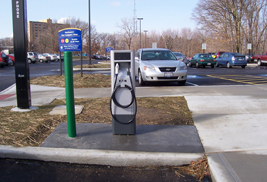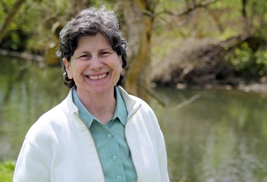Featured Article
Kent State University at Stark Professor Coordinates Hoover Initiative on the Environment
Puzzles intrigue Associate Professor of Biological Sciences Penny Bernstein, Ph.D. Whether they are presented in a colorful box, in the natural world or as part of her work, her first inclination is to look carefully for patterns that lead to a solution.
read moreKent State Fire Prevention Office Installs Electric Charging Station for Energy-Efficient Transportation
Posted June 25, 2012 | Katie Fickle
An electric charging station has been installed in front of
Harbourt Hall by Kent State’s Fire Prevention Office for its
new battery-powered Chevrolet Volt.
Kent State University’s Fire Prevention Office has expanded its efforts to go green with the installation of an electric charging station for its new battery-powered Chevrolet Volt. The charging station was installed outside Harbourt Hall.
Charmaine Iwanski, architect in the Office of the University Architect, says the charging station is currently available only for University Facilities Management vehicles. Future charging stations are likely; however, funding, availability, usage policies and locations have yet to be determined.
“I think the new charging station will encourage more electric vehicles on campus,” Iwanski says.
The Volt is powered by an electric motor. The electric motor runs on batteries; however, once the batteries are discharged, an internal gas-powered electric generator will start and power the car’s electric motor.
Kent State purchased the charging station from Eaton Corporation. Dave Bajzel, an Eaton manufacturing employee, explains that powering the car by battery is the most efficient option for the vehicle. Bajzel says using the station will save the fire safety department money because it will enable the car to run on electricity more than gas. The station charges the car in four hours; whereas, the original charging device that came with the Volt charges the car in 20 hours.
“With gas prices increasing, it’s cheaper for the Volt to run on electricity,” Bajzel says.
Carmine Ricchetti, electrical engineer in the Office of the University Architect, says that the station enables the university's facilities management to use more fuel-efficient vehicles. Ed Moisio, fire safety and prevention services coordinator, has reported fewer fill-ups.
Melanie Knowles, sustainability manager for Facilities Planning and Operations, explains that the university is looking to expand energy-efficient options for more drivers.
“Installing additional charging stations is about making transportation options available on campus,” Knowles says. “We want to accommodate drivers who are interested in plug-in electric vehicles.”
The Office of the University Architect is considering the installation of additional charging stations as demand necessitates.
For more information about fire safety, visit www.kent.edu/publicsafety/fireprevention/index.cfm.
